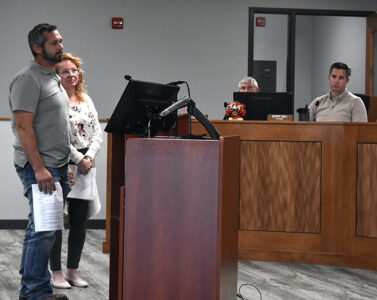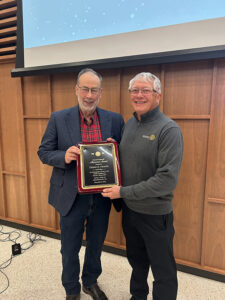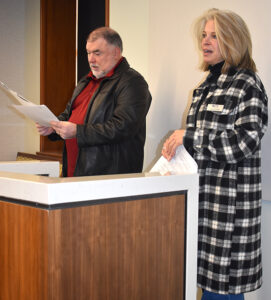Council considers funding options for abatement, redevelopment of East Main Street building
As city leaders work to redevelop the building that formerly housed the Angels store at 20 E. Main St., Marshalltown Housing and Community Development Director Deb Millizer updated the council on the status of a federal grant application during last Monday night’s meeting, and the council agreed to wait two more months before firmly deciding on a definitive course of action.
As Millizer explained, the city took possession of the property in 2022 through the 657A process, which refers to abandoned or unsafe buildings in the Iowa Code, and in January, they solicited Requests for Proposals (RFPs), with the only one submitted coming from In Stitches owners Phil and Elisabeth Curtis.
By acquiring the building, the Curtises hope to expand their embroidery businesses with sewing classes and other new offerings. In order to prepare the building for ownership to be transferred, Millizer said she and her staff have brought a structural engineer and other professionals in to look at the building and received quotes for asbestos abatement.
The hiccup is that she applied for a Department of Natural Resources (DNR) brownfield grant for up to $25,000 to deal with the asbestos, and the funds have not been released through the Environmental Protection Agency (EPA).
“Each time I check on that, I continually get told to check back in a couple of weeks, and it just continues to drag out the process. And I checked in a few weeks ago, and it was the same response,” Millizer said. “So we need to find a path to be able to move forward with this.”
Currently, there is no access from the first floor to the second floor, so a hole will need to be cut to allow for a lift to be brought in and remove the asbestos. Additionally, the mezzanine is not safe for anyone to walk on at this point, and water service will need to be restored. Because of the age of the building, leaks are likely, and Millizer said the total cost of the aforementioned work is estimated at between $31,000 to $37,000.
“When I started in February working on this project, I thought it was gonna be pretty easygoing, but I soon learned that there’s always another hiccup in the process. So I’m asking to find a funding stream of up to $50,000 so that we have the funds available,” she said.
Her ask to the council was to decide on whether they wanted to wait longer for an update on the federal grant or proceed through another funding source — a direct payment from the Local Option Sales Tax (LOST) fund, an interfund loan from LOST requiring a budget amendment and loan repayment scheduled through future bond proceeds or an interfund loan through the Water Pollution Control enterprise utility requiring council approval for loan resolution with repayment scheduled from future bond proceeds.
If the city moves forward with a different funding option than the grant, she noted, they would no longer be eligible to receive the grant retroactively. City Administrator Carol Webb said a project like this would normally be funded through the Dangerous and Dilapidated (D&D) program, but it is currently low on dollars with other upcoming items also needing the money.
According to Webb, the LOST and Water Pollution Control borrowing options would give the city a “bridge” until more D&D funds can be bonded for in the future, and she recommended the Water Pollution Control option. Councilor Jeff Schneider asked why they weren’t just waiting for an answer on the Brownfield grant.
“It’s slowing down the redevelopment of the property, and I know that the city wanted to move it quickly and move it into the Curtises hands so that they could do their business,” Millizer said. “(The) center block of Main Street, we have our reconstruction going on. It’s just a big hurdle in order to move the project forward. And I don’t know when the Brownfield funds will be released or if they will be released, so we might just be sitting indefinitely if we wait for that. And there’s no guarantee that we are definitely going to get it.”
In response to another question from Councilor and Mayor Pro-Tem Mike Ladehoff, Millizer told him the city had first applied for the grant back in May and has repeatedly been told to “check back in a few weeks” since then. Councilor Greg Nichols then asked Phil Curtis, who was in attendance, about what kind of a timeframe he was looking for on the project.
Curtis cited the fact that the business’s current space is only about 1,000 square feet as a reason they are trying to move forward with the new building.
“We know we have some bigger things coming up that we need to spread out with, and we just don’t have the room,” he said.
Ideally, the waiting period would be “none,” but Curtis acknowledged that with their busy season coming up, he didn’t think he would be able to start on the project until December or January, so he didn’t have an issue with waiting another month or two. Nichols then motioned to wait for two more months.
Councilor Gary Thompson asked if the abatement work had to be completed before the Curtises could take possession, and there was no way that they could do it themselves. Millizer replied that they couldn’t redevelop the building until the asbestos was removed.
“What I’m thinking is, we’re TIFing (Tax Increment Financing) everything else. We’ll TIF a doghouse if it gets built. So why don’t we… Phil, do you have the funds to do this yourself if you got reimbursed through TIF on your taxes?” Thompson asked.
Curtis said he could take out a loan and make it work, and he had discussed either TIF or a property tax abatement with Millizer as other options. Thompson agreed with the idea of waiting on the Brownfield grant but also expressed concern about delaying the transfer of ownership for too long.
Curtis said he could do all of the work other than the asbestos removal but felt it would be a conflict of interest for the city to hire him, and Webb noted that only the city could apply for the Brownfield grant. Typically, Webb said, development agreements are reserved for larger projects, but a forgivable loan could be another option.
Finance Director Diana Steiner opined that it would be “difficult” to arrange a TIF agreement because there wasn’t much increment involved in repairing a building, and Councilor Barry Kell sensed that the council desired to wait about six to eight more weeks with the opportunity for “creative solutions” in the meantime.
“As opposed to rushing to a solution right now, let’s wait a little longer to see how this grant plays out, but in the meantime, work with the Curtises, work with available options for funding sources and see if we can come up with something,” he said. “I don’t even want to guess what that outcome is, but I think there’s probably a workable solution there.”
During the public comment period, Jim Shaw said the council should not plan on receiving the federal grant because of the state affairs with the current administration, which has denied a wide range of grant requests since President Donald Trump took office.
The original motion to wait two more months while exploring other options in the meantime passed by a unanimous 7-0 vote.
- T-R PHOTOS BY ROBERT MAHARRY — In Stitches Co-Owner Phil Curtis and Marshalltown Housing and Community Development Director Deb Millizer address the city council during last Monday night’s meeting about the status of a federal asbestos abatement grant for the former Angels building at 20 E. Main St. The council voted unanimously to wait for two more months while exploring other funding options in the meantime.
- A recent view of the former Angels building at 20 E. Main St. The city of Marshalltown has owned the property since 2022 after taking ownership through Chapter 657A of the Iowa Code.








